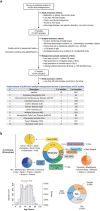This is a preprint.
Gut Microbiome Wellness Index 2 for Enhanced Health Status Prediction from Gut Microbiome Taxonomic Profiles
- PMID: 37873265
- PMCID: PMC10592848
- DOI: 10.1101/2023.09.30.560294
Gut Microbiome Wellness Index 2 for Enhanced Health Status Prediction from Gut Microbiome Taxonomic Profiles
Update in
-
Gut Microbiome Wellness Index 2 enhances health status prediction from gut microbiome taxonomic profiles.Nat Commun. 2024 Aug 28;15(1):7447. doi: 10.1038/s41467-024-51651-9. Nat Commun. 2024. PMID: 39198444 Free PMC article.
Abstract
Recent advancements in human gut microbiome research have revealed its crucial role in shaping innovative predictive healthcare applications. We introduce Gut Microbiome Wellness Index 2 (GMWI2), an advanced iteration of our original GMWI prototype, designed as a robust, disease-agnostic health status indicator based on gut microbiome taxonomic profiles. Our analysis involved pooling existing 8069 stool shotgun metagenome data across a global demographic landscape to effectively capture biological signals linking gut taxonomies to health. GMWI2 achieves a cross-validation balanced accuracy of 80% in distinguishing healthy (no disease) from non-healthy (diseased) individuals and surpasses 90% accuracy for samples with higher confidence (i.e., outside the "reject option"). The enhanced classification accuracy of GMWI2 outperforms both the original GMWI model and traditional species-level α-diversity indices, suggesting a more reliable tool for differentiating between healthy and non-healthy phenotypes using gut microbiome data. Furthermore, by reevaluating and reinterpreting previously published data, GMWI2 provides fresh insights into the established understanding of how diet, antibiotic exposure, and fecal microbiota transplantation influence gut health. Looking ahead, GMWI2 represents a timely pivotal tool for evaluating health based on an individual's unique gut microbial composition, paving the way for the early screening of adverse gut health shifts. GMWI2 is offered as an open-source command-line tool, ensuring it is both accessible to and adaptable for researchers interested in the translational applications of human gut microbiome science.
Conflict of interest statement
Competing Interests D.C., V.K.G., and J.S. disclose that a patent application was filed relating to the materials in this manuscript. All other authors declare no competing interests.
Figures





References
-
- Mars R. A. T. et al. Longitudinal multi-omics reveals subset-specific mechanisms underlying irritable bowel syndrome. Cell 183, 1137–1140 (2020). - PubMed
Publication types
Grants and funding
LinkOut - more resources
Full Text Sources
